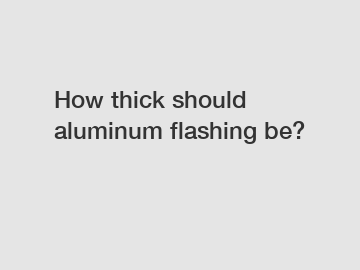How thick should aluminum flashing be?
Aluminum flashing is a common material used in construction to protect buildings from water infiltration. It is a thin sheet of aluminum that is installed around windows, doors, and other vulnerable areas to prevent water from seeping in and causing damage. One important consideration when choosing aluminum flashing is the thickness of the material. The thickness of aluminum flashing can vary, and it is essential to select the appropriate thickness for your specific needs. In this article, we will discuss how thick aluminum flashing should be to ensure its effectiveness in protecting your home.
The Purpose of Aluminum Flashing.
Aluminum flashing serves as a protective barrier to prevent water from entering key areas of a building. It is commonly used in conjunction with other building materials, such as shingles or siding, to create a watertight seal. When installed correctly, aluminum flashing helps to divert water away from vulnerable areas, preventing leaks and water damage. It is a crucial component of any building's exterior envelope, helping to maintain its structural integrity and longevity.

Factors to Consider When Choosing Aluminum Flashing Thickness.
When selecting the thickness of aluminum flashing for your project, several factors should be taken into account. One of the primary considerations is the expected exposure to the elements. In areas with heavy rainfall or high winds, thicker aluminum flashing may be necessary to provide adequate protection. Additionally, the design of the building and the potential for water infiltration should be considered when determining the appropriate thickness of aluminum flashing. Thicker flashing is often recommended for areas prone to leaks or damage.
Standard Thicknesses of Aluminum Flashing.
Aluminum flashing is available in a range of thicknesses, typically measured in mils or gauge. A mil is equal to one-thousandth of an inch, while gauge is a measurement of thickness based on a set standard. The most common thicknesses of aluminum flashing range from 0.019 inches (26 gauge) to 0.032 inches (20 gauge). Thinner flashing, such as 0.019 inches, is suitable for less demanding applications where exposure to the elements is minimal. Thicker flashing, like 0.032 inches, is recommended for areas that require more robust protection against water infiltration.
Choosing the Right Thickness for Your Project.
When determining the appropriate thickness of aluminum flashing for your project, it is essential to consult with a building professional or contractor. They can assess the specific needs of your building and recommend the most suitable thickness of aluminum flashing. Factors such as the architectural design of the building, local weather conditions, and potential vulnerabilities should be taken into consideration when selecting aluminum flashing. By choosing the right thickness of aluminum flashing, you can ensure that your building is adequately protected against water intrusion and potential damage.
In conclusion, the thickness of aluminum flashing plays a significant role in the effectiveness of its performance. By selecting the appropriate thickness based on your project's specific needs, you can ensure that your building is adequately protected against water infiltration. If you have any questions or need assistance with choosing the right thickness of aluminum flashing for your project, please contact us. Our team of experts is here to help you make an informed decision and ensure the long-term durability of your building.
If you are looking for more details, kindly visit painted aluminium coil, anti-scratch painted aluminium coil, aluminium roof coil.
63
0
0


Comments
All Comments (0)